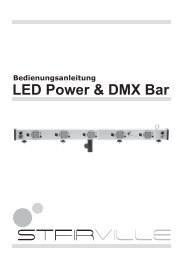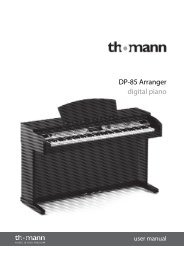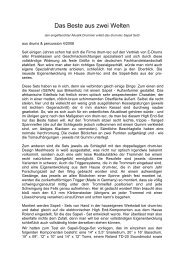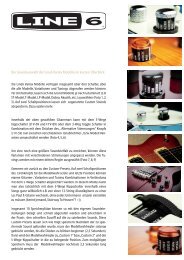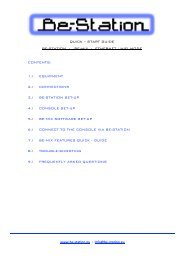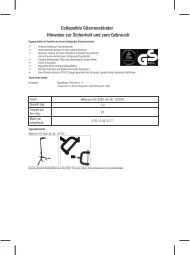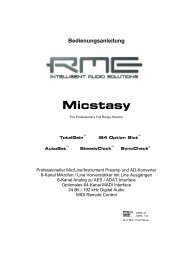Create successful ePaper yourself
Turn your PDF publications into a flip-book with our unique Google optimized e-Paper software.
Special concerns for hihats<br />
Hihats have a few extra fade parameters, as in many ways the hihat has the most complex choking behaviour within a drumkit.<br />
There are 3 separate choke fade types for hihats: pedal notes and closed tip notes have separate choke fade times to the rest of<br />
the hihat’s articulations. It is recommended that the pedal and closed tip choke fade times are kept at low values, while the other<br />
hihat choke fade times (covering all open articulations as well as the closed shank articulation) should be kept at higher values.<br />
The pedal is the only thing that chokes an open hihat when playing a drumkit. When playing BFD2’s sounds from an electronic<br />
drumkit, the pedal note sent out when the pedal is moved down fully is the note used to choke an open hihat.<br />
It has also become conventional for sample-based drumkits to choke open hats with a closed hat note. Therefore, the closed tip<br />
choke fade time is also provided and is set to a low value by default.<br />
Open hihat positions and the closed shank articulation are splashier sounds that react similarly to cymbals when played repeatedly<br />
in succession.<br />
Default choke fade (base)<br />
Default choke fade (range)<br />
Hihat choke fade (base)<br />
Hihat choke fade (range)<br />
Hihat closed tip choke fade<br />
Hihat pedal choke fade<br />
Tom choke fade (base)<br />
Tom choke fade (range)<br />
Cymbal choke fade (base)<br />
Cymbal choke fade (range)<br />
Cymbal choke fade (manual)<br />
Detail<br />
1<br />
The minimum fade time for all kit-piece slots without individual<br />
fade times (kicks, snares and percussion).<br />
The maximum fade time for all kit-piece slots without individual<br />
fade times (kicks, snares, percussion).<br />
The minimum fade time for the hihat slot.<br />
The maximum fade time for the hihat slot.<br />
The choke fade time applied to previous hihat sounds<br />
when a closed tip hihat is triggered.<br />
The choke fade time applied to previous hihat sounds<br />
when a pedal hihat is triggered.<br />
The minimum fade time for the tom slots.<br />
The maximum fade time for the tom slots.<br />
The minimum fade time for cymbal slots.<br />
The maximum fade time for cymbal slots.<br />
The choke fade time for manual choking a cymbal using<br />
the slot choke articulation, or using poly pressure messages<br />
sent out by electronic drumkits.<br />
The Detail settings allow you to set the level of velocity layer detail for each kit-piece class: kicks, snares, hihats, toms, cymbals<br />
and percussion.<br />
These settings operate relative to the Max velocity layers setting – in other words, the lower detail levels proportionally reduce the<br />
number of layers specified in this setting. Velocity layers are selected at proportional intervals over the velocity range, so you still<br />
get the benefits of BFD2’s natural variations in kit-piece timbre and dynamics, only with less ‘resolution’ over the velocity range.<br />
Four detail levels are available:<br />
Minimal<br />
Only one velocity layer is loaded for each articulation in the kit-piece class. The Vel to Amp setting for each loaded articulation is<br />
automatically set to +100%, in order to scale the volume over the velocity range.<br />
Small<br />
BFD2 loads approximately a quarter of the ‘max velocity layers’ setting for each articulation in the kit-piece class.<br />
Medium<br />
Approximately half of the max velocity layers setting are loaded for each articulation in the kit-piece class.<br />
Large<br />
The maximum possible amount of layers, as specified by the max velocity layers setting, are loaded for each articulation in the<br />
kit-piece class.








